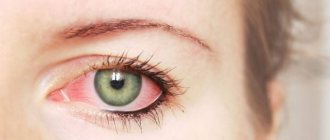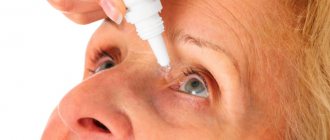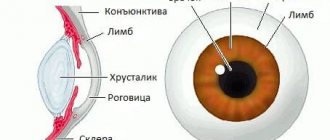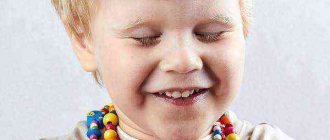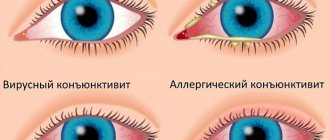Conjunctivitis in children under one year of age is a common phenomenon that occurs due to viruses and infections getting into the eyes, as well as an allergic reaction. Dacryocystitis is sometimes observed in infants. This is an inflammatory disease associated with obstruction of the tear ducts. Let's consider what to do in this case, what measures to take.
In this article
- What is conjunctivitis?
- Conjunctivitis at three months: what happens?
- How to recognize conjunctivitis in a 3-month-old baby?
- How to treat conjunctivitis in a child?
- How to treat conjunctivitis in a child?
- A child has dacryocystitis at 3 months: what to do?
- How to treat dacryocystitis in a 3-month-old baby?
- What to do if dacryocystitis does not go away?
- Prevention of childhood conjunctivitis
- How dangerous is conjunctivitis?
Why does a child rub his eyes?
• The most common and at the same time common cause is the entry of a foreign body into the eye.
For discomfort, an eyelash, dust or hair on the mucous membrane is enough. In this case, the object that caused the discomfort may not be in the eye - slight damage to the eyeball can already cause the child to rub his eyes. • The cause of this reaction may be an inflammatory process accompanied by itching. Bacterial or infectious contamination can trigger this type of reaction.
• Pain or poor vision. A child, like an adult, can rub his eyes due to poor vision - do not forget about this.
• Allergic reactions are an equally common reason for this behavior.
What are the types of eyelid edema?
Both the lower and upper eyelids of a child may swell. What is the difference? There is no significant difference, but ophthalmologists still identify some reasons why swelling occurs either above or below the eye. If the upper eyelid is swollen, then fatty tissue may have accumulated in the subcutaneous layer. Also, swelling of the upper eyelid signals diseases of the digestive system, chronic kidney or heart disease. The reasons may also lie in allergic reactions occurring in the body.
The above reasons also provoke swelling of the lower eyelid. However, there is an opinion that swelling of the eyelid (lower) is considered one of the signs of problems with the cardiovascular system or thyroid gland.
When to worry
Here are signs of trouble that should force parents to see a doctor as soon as possible:
- the appearance of swelling of the eyelids;
- redness of the eyelids;
- prolonged release of tears;
- the appearance of other discharge from the eye;
- souring of the eyes.
Wiping a child's eyes has no negative consequences. The only unfavorable consequence of this is the appearance of small scratches and wounds around the eyes. They can become irritated, fester, or become inflamed. To prevent your child from accidentally injuring the skin around his eyes, you need to cut his nails short. At night, you can protect your skin with special mittens.
But if a child’s eyes itch at primary school age, you need to show him to a doctor to check his visual acuity. The fact is that a constant desire to rub your eyes may be associated with a decrease in visual acuity as a result of myopia (myopia). The sooner myopia is detected in a child and treated, the better the outcome of therapy.
Why is itching in the eyes and nose dangerous?
If a toddler not only rubs his eyes, but also has a stuffy nose, this is an alarming situation. Allergic rhinitis can appear in the first month of a child’s life. Not all parents are able to immediately recognize the problem, so the baby is first treated for ARVI.
When a child's eyes itch due to allergies, all the mucous membranes swell. Therefore, the nasal sinuses and the upper region of the larynx are involved in the process. Increased friction of the eyelids provokes copious secretion of tears. Some of the fluid leaks out through the sinuses, which are already clogged. All this makes breathing difficult and can provoke asthmatic syndrome.
Conjunctivitis is often of an allergic nature and is manifested by a severe burning sensation in the eyes. The child has to constantly scratch his eyelids, which leads to damage to the mucous membrane. As a result of disruption of the protective film, the conjunctiva becomes infected and the hair follicles become inflamed.
When you shouldn't worry
Most often, a child rubs his eyes when he wants to sleep. This is a natural reaction of a child's body to fatigue. Therefore, if such behavior is observed before the child goes to bed, you should not worry at all.
Often mothers pay attention to the fact that the baby rubs his eyes when he is teething. Most often, this is one of the first signs that a quiet life will soon come to an end. In addition, children often rub their nose.
You should definitely pay attention to whether there are other symptoms besides the fact that the child constantly rubs his eyes. If there are none, you shouldn’t worry for no reason.
Slight redness, coupled with the child’s desire to rub his eyes, may also indicate that foam or water may have gotten onto the mucous membrane during bathing. Naturally, the irritant will not be detected upon examination, but this type of injury may lead to the desire to rub the disturbing eyes.
When you don't need to worry
A child may rub and scratch his eyes for the following reasons:
- The baby wants to sleep. In this case, there is no need to worry, as this is a normal reaction to fatigue.
- If a baby rubs his eyes and nose, scratches his ears, then most likely he is teething. During this period, children become capricious and irritable; their bowel movements may change, their temperature may rise, and their appetite may disappear.
- When there is a sharp change in darkness and light, the baby may also rub his eyes.
- A change in daily routine can also cause your baby to periodically scratch his eyes.
- While bathing, water, soap, shampoo or foam may get into your child's eyes. Even after bathing, the irritant remains on the mucous membrane for some time, which causes itching of the eyes.
When the situation is more serious
There is no need to sound the alarm, but it is better to show the child to a specialist if the following is observed:
- swelling of the eyelids;
- redness;
- tearing or discharge from the tear glands;
- “sticking” of the eyelids after sleep.
These facts may be an indicator of the presence of a disease or allergy. A child often rubs his eyes because something is bothering him. For example, it could be an allergy. The causative agent may be dust, pillow filling, pollen and other irritants. Only a special examination will help determine or exclude this possibility.
The entry of a foreign body into the eye cavity can also provoke a child’s desire to constantly rub the eye. It's about suppressing discomfort. First of all, you should carefully check the baby’s eyes, and preferably also rinse them with water.
What other reasons could there be for swelling of the lower and upper eyelids in a child?
Continuing the topic of the causes of eyelid swelling in a child, it is worth noting that the upper eyelid usually swells in a child, since his skin is thinner and more delicate. In most cases, ophthalmologists are faced with the causes of swelling of the upper eyelid in a child, which we described above. But if we are talking about babies who are not yet a year old, then swelling of the upper eyelid can be a symptom of teething. In this case, only one eye is subjected to the process. At this age, of course, there is no point in talking about swelling of the eyelids due to overstrain of the visual organs. However, there are factors that can provoke so-called indirect fatigue and eye strain and, as a result, swelling of the upper eyelid. For example, children staying for a long time in too dark or light rooms. A predisposition to temporary deformations of eye tissue can often cause swelling of the upper eyelid in a child. It is quite difficult to answer the question of why this happens, despite the great breakthrough in medicine not only in ophthalmology, but also in other fields.
If we exclude the listed pathological conditions and disorders, the upper eyelid in an older child may swell due to lack of sleep, overwork and overstrain of the visual organs, with excessive consumption of salty and spicy foods, as well as due to drinking too much before bed. Sometimes the cause of swelling is improper blood flow from the muscle tissue of the visual organs, but usually this pathology is accompanied by additional symptoms - the eyes may turn red and itching appears.
When to see a doctor
In general, any unpleasant symptom or deviation from the norm is a reason to consult a specialist. Of course, you shouldn’t call an ambulance for this, but you shouldn’t delay your visit to the doctor.
The most striking indicator that a child should be shown to a specialist is the appearance of discharge from the eye cavity or excessive tearing. In this case, the reasons that the child rubs his eyes may be much more serious.
The likely cause is the development of conjunctivitis caused by infection with Staphylococcus aureus. We should not forget about the possibility of infection with demodicosis mites, which multiply in the eyelash pockets.
Often a child rubs his eyes due to the presence of stye - purulent inflammation in the eyelid cavity. In this case, the causes of discomfort are immediately obvious, since they are visually clearly distinguishable.
The reasons may be different, but if you see that something is really bothering your child, it is still better to show him to a doctor. This will eliminate the most unpleasant possible causes and help establish ways to get rid of the current problem. If a child rubs his eyes, this is a signal from the body in response to a certain stimulus. The parents’ task is to find out why this happens, what the baby’s body says using this signal.
Prevention
Preventive measures are as follows:
- adherence to daily routine;
- maintaining a balance of visual load;
- avoidance of physical overload;
- maintaining a balanced diet;
- teaching the child to observe the basic rules of personal hygiene;
- compliance with hygiene rules while caring for the baby.
To prevent symptoms such as itching, gas, runny nose and swelling, you need to teach your child not to touch his face with dirty hands and follow the rules of hygiene. A timely visit to your doctor if your child is in pain, has swollen eyes or a stuffy nose will help you avoid unpleasant consequences. In some cases, when swelling quickly spreads to other parts of the body, an urgent call to the ambulance and emergency hospitalization are required.
▼We RECOMMEND YOU TO STUDY▼
What is eyelid edema in a child?
Swelling of the upper eyelid in a child is an excessive accumulation of fluid in a certain place. This disease can be short-term or chronic. In most cases, only one lower or upper eyelid may swell. Parents often experience that their child’s eyelids swell after sleep. Ophthalmologists say that in this case there can be no cause for concern - this is the absolute norm. What if swelling of the child’s eyes does not go away during the day and is accompanied by poor health and complaints of pain in the eyes?
Then ophthalmologists recommend making an appointment, since your child may have some kind of disease that is not even related to ophthalmology.
Foreign body entry
The most common reason why a baby rubs his eyes is a foreign object getting into them. Even an eyelash or a grain of sand can cause an unpleasant feeling of discomfort. Do not forget that the presence of the smallest object in a baby’s eye can cause a lot of complications. The child will reflexively try to get rid of the foreign body, begin to scratch his eyes with his hands and can cause an infection.
If a grain of sand or speck gets into the baby’s eye, the procedure for parents is as follows:
- conduct an eye examination and identify its location;
- Rinse your eyes with boiled water or weak tea.
If a large foreign body or parents cannot cope with the problem on their own, then it is better to consult an ophthalmologist as soon as possible. Your attempts to remove the object can cause pain and only harm the child, while a specialist will deal with this quickly and painlessly.
Possible causes of itchy eyes in a child
It is impossible to miss the appearance of problems in a baby: the baby becomes restless and irritable. Individual symptoms will more clearly indicate the cause of this condition. In particular, itchy eyes usually suggest a local problem rather than a systemic disease.
Pathological
The most common cause of itchy eyes is the activation of pathogens due to infection. The diagnosis can be made very differently (depending on the location of the inflammatory process):
- conjunctivitis;
- blepharitis;
- uveitis;
- blockage of tear ducts.
Typically, this causes swelling of the tissues of the organ of vision, redness of the whites of the eyes, and increased lacrimation.
Itchy eyes can also be a sign of allergies. The child’s body is quite weak and does not always adequately perceive the surrounding world, particles of which may be allergens. Especially often, such manifestations appear in the autumn-summer period, as well as after the appearance of new dishes on the menu.
Very often, the reason why a baby’s eye itches is that a foreign body – a speck or grain of sand – gets into it. Unlike adults, children do not always keep their hands clean, and they then rub their faces with the same hands, including touching the mucous membrane of the eyeball. The consequence of this is irritation, discomfort and itching.
A provocateur of this condition can be eye fatigue. This is especially true for preschool and school-age children who like to spend time in front of a monitor screen or gadgets (phones, tablets). This modern trend is leading to earlier onset of vision problems. Fatigue in the eyes and itching indicate the body’s inability to recover, and it needs a break.
If the baby begins to show anxiety and rub his eyes, then there is a high probability that the cause is the growth of new teeth. If you look into your baby's mouth, you will see swollen gums - a harbinger of the imminent appearance of teeth. There are special products that, when applied to the gums, reduce pain and cool the tissue. The baby forgets about the pain and feels good again.
However, it is still worth sharing your concerns with your pediatrician, because it is very easy to miss the symptoms of serious diseases.
Causes
The causes of discomfort in the eyeballs or eyelids can vary, from simple lack of sleep to serious injury. The list of main factors that can explain to you why your baby’s eyes itch is quite extensive.
Allergy
Often it is the itching felt in the eye area that indicates that the child has an allergy. In addition, the extent of damage to the eyelids and eye tissue depends on the causes of the allergic reaction.
Allergies and stuffy nose - these symptoms mainly appear during seasons when all kinds of plants are in bloom, in apartments where long-haired animals live, or due to infrequent cleaning and the presence of house dust.
Foreign object
If the eye is watery and itchy, the itching may indicate the presence of a foreign object, for example, a speck of dust, a midge, or a grain of sand trapped behind the eyelid. Such small objects can be difficult to examine and remove, especially in an infant. Foreign bodies cause itching and burning, redness of the mucous membrane.
Fatigue and overexertion
If your child has one or both eyes itching, the causes of this symptom can be explained by fatigue and overexertion. The most negative impact is caused by computer and TV screens. In order for mothers to rest their eyes, they need to teach their children to take a break when watching cartoons on TV or on the computer.
Obstruction of the lacrimal duct
If you notice that the corners of your baby's eyes are very itchy, the signs may indicate congenital obstruction of the tear duct. With this problem, the eyes are not moistened with tears and dry out, which is why unpleasant symptoms occur in children.
Conjunctivitis
Red eyelids that are swollen may indicate an infection with conjunctivitis. Conjunctivitis occurs for various reasons; the child may have an allergy or a virus. Allergies in the form of conjunctivitis occur due to the contact of chemicals or cosmetics with the mucous membrane. Low-quality toys also provoke allergic conjunctivitis, which makes the corners of the eyes itch.
Wound healing
Redness in the eyes of a child can be observed during the healing period of a wound. In this case, itching appears due to the healing substances produced by the child’s body.
Treatment method
It depends on the cause that caused the corresponding symptoms. Most often, medicinal antibacterial and anti-inflammatory drugs are used (topically for conjunctivitis, orally for colds or general systemic diseases).
Colds are treated with anti-inflammatory or antibacterial drugs, more often in the form of tablets or syrups (therapy for very young children involves the use of rectal suppositories). These may be drugs such as Panadol, Nurofen, Sumamed, Augmentin, etc.
Children are prescribed medications such as Fenistil, Zyrtec, Suprastin, which are taken orally. The specialist may also recommend taking local remedies (drops and ointments) with an antiallergic component (Prevalin).
First aid
First of all, you need to carefully examine the eye. If possible, it is necessary to slightly retract the upper and lower eyelids and conduct an examination. Perhaps a grain of sand, an eyelash, or a speck has stuck to the mucous tissue under the eyelid. It is best to remove it with the corner of a napkin or scarf. It is inconvenient to do this with your hands (fingers), and hand hygiene is not always the best even among adults.
If itching in the eyes is clearly caused by overwork, then it is urgent to turn off and remove all gadgets, including the computer and TV, from visibility. It's best to dim the lights to give your eyes a rest.
If the baby shows an inflammatory process in the tissues of the eye, then the only thing you can do on your own is rinsing.
What and how to rinse
This procedure is extremely important. Firstly, rinsing allows you to clean the mucous membrane of the eyeball from foci and waste products of pathogens. This means that the local remedies used will be more effective. Secondly, rinsing compositions have a slight antiseptic property, which means they disinfect the surface of the eye and reduce the inflammatory process.
So what can you use for rinsing? The simplest recipe is tea leaves (of course, without sugar), saline solution or a weak solution of potassium permanganate. The potassium permanganate solution should be almost transparent and have a subtle pink tint. Otherwise, you can burn the mucous membrane of the eyeball, and the eye will have to be treated for a chemical burn.
How exactly is the procedure carried out? The easiest way to do this is with sterile cotton pads. Wetting the cotton pad generously, wipe your eyes from the outer corner to the inner. Do not reuse a used cotton pad. After rinsing, you need to give your eyes a rest. How often should you wash your eyes? The procedure is performed 4-6 times a day, and always before instilling the medicine.
Inflammation of the eye
This pathology is diagnosed in infants quite often and can have the following forms:
- barley;
- inflammation of the eyeball, tear ducts or eyelid;
- furuncle.
With any of these diseases, the baby constantly rubs his eyes, he experiences symptoms such as lacrimation, redness of the eyelid, swelling, copious discharge (usually purulent), itching and pain in the eyelids, increased sensitivity to light, possible blurred vision and increased temperature. If these symptoms appear, you should immediately consult a doctor and undergo an examination. It is important for parents to remember that they should not self-medicate. This can lead to a worsening of the situation and provoke the development of complications.
Restless teeth
Many mothers notice that quite often the child rubs his eyes and nose before teething. These are not the only signs that your baby will soon have one more tooth. Attentive mothers note the following signs of the imminent appearance of a new tooth:
- copious clear snot;
- increased body temperature;
- increased moodiness;
- increased salivation;
- the child gnaws and chews everything that comes to hand;
- decreased appetite;
- constipation or diarrhea;
- swelling of the gums in the place where the tooth is about to erupt.
If, against the background of some of these symptoms, the child rubs his eyes and nose, then most likely this is a sign that your baby will soon erupt a new tooth.
Conjunctivitis
This disease is characterized by inflammation of the conjunctiva of the eye due to a bacterial or viral infection, as well as allergies. Symptoms of conjunctivitis in infants are:
- itching and burning;
- photophobia;
- sticking of eyelids after sleep;
- formation of purulent yellow crusts;
- swelling and redness of the eyes.
In addition, the baby may not eat well, sleep poorly, become capricious and whiny. Nowadays, pharmacies have a fairly large selection of anti-conjunctivitis medications. However, only a doctor can advise individual treatment.
Washing rules
So, the parents’ actions, if the baby rubs his eyes and the doctor recommends rinsing, will be as follows:
- put the baby on a changing table or bed;
- take a solution for washing (neither hot nor cold, optimally at room temperature);
- moisten a clean swab or cotton wool and gently rub it over the eye (it is better to lead to the nose, paying special attention to the corners);
- We blot the baby's eye with a napkin soaked in boiled water.
There is another way to wash your baby's eyes. You will need a regular medical pipette for this. First, you need to take the rinsing liquid into a pipette, drop it into the baby’s eye, then turn the baby’s head to the side. The liquid will flow out on its own through the outer corner. After the procedures, it is necessary to leave the baby in a lying position for 20-30 minutes.
- put the baby on a changing table or bed;
- take a solution for washing (neither hot nor cold, optimally at room temperature);
- moisten a clean swab or cotton wool and gently rub it over the eye (it is better to lead to the nose, paying special attention to the corners);
- We blot the baby's eye with a napkin soaked in boiled water.
How to instill drops correctly
When a baby rubs his eyes with his hands and there is a need to rinse and put drops into the eyes, you need to know the following:
- observe hand hygiene: when performing procedures, hands should be clean, nails should be cut short;
- the solution and drops should be warm or at room temperature;
- the child must be distracted from the procedure in every possible way so that he is not afraid;
- It is better to sterilize the pipette by boiling it or lubricating it with a special liquid;
- Before instilling the drops, the baby’s eyes need to be rinsed;
- the baby must be placed on his back, his head tilted back (you can swaddle the baby at this time so that he does not wave his arms);
- when instilling drops, the baby’s eyelid should be pulled back, the drops should be dropped and released; you should avoid touching the mucous membrane of the baby’s eye with your own hands;
- After instilling the drops, you can massage the eyelid so that the medicine disperses.
The procedures for instilling drops and washing the eyes of a baby are simple. Don't be nervous, worry or rush. The child will not cry and kick if he feels the mother’s confidence and calmness.
- observe hand hygiene: when performing procedures, hands should be clean, nails should be cut short;
- the solution and drops should be warm or at room temperature;
- the child must be distracted from the procedure in every possible way so that he is not afraid;
- It is better to sterilize the pipette by boiling it or lubricating it with a special liquid;
- Before instilling the drops, the baby’s eyes need to be rinsed;
- the baby must be placed on his back, his head tilted back (you can swaddle the baby at this time so that he does not wave his arms);
- when instilling drops, the baby’s eyelid should be pulled back, the drops should be dropped and released; you should avoid touching the mucous membrane of the baby’s eye with your own hands;
- After instilling the drops, you can massage the eyelid so that the medicine disperses.
